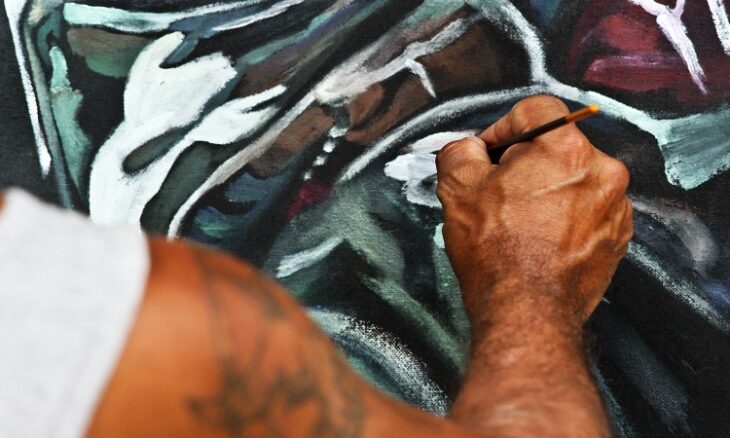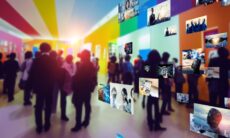Indigenous Artists Reimagine the Met Through Augmented Reality
On Indigenous Peoples’ Day, 13 October, seventeen Native artists initiated an unsanctioned digital intervention inside the Metropolitan Museum of Art’s American Wing. Using augmented reality (AR), they digitally transformed nineteenth-century paintings, depictions of imagined landscapes, affluent settlers, and historical grandeur, by overlaying them with Indigenous cosmological figures, pow-wow dancers, and intricate layers of ivy. The project, titled ENCODED: Change the Story, Change the Future, runs until 31 December and was co-curated by filmmaker and curator Tracy Renée Rector alongside an anonymous Indigenous co-curator, in collaboration with Amplifier, a non-profit design and media lab.
The digital installation coincides with the centenary of the American Wing, prompting questions about the narratives told through American art and who determines what is worthy of display. The project challenges traditional museum practices by offering an alternative means for Indigenous representation, particularly when institutional inclusion remains limited.
In recent years, the Metropolitan Museum has taken incremental steps to integrate Native art into its spaces. In 2020, it appointed Patricia Marroquin Norby as the first associate curator of Native American art. A year later, it introduced the Charles and Valerie Diker collection, showcasing 139 works from over 50 tribes. However, these pieces were placed in a segregated section of the American Wing, revealing the ongoing issue of cultural marginalisation. Earlier in 2024, the museum presented an exhibition dedicated to Ojibwe Abstract Expressionist painter George Morrison, which remains on view until May 2026. Yet, the display was installed apart from Morrison’s contemporaries, such as Helen Frankenthaler and Jackson Pollock, underlining a persistent separation of Native works from mainstream narratives.
Among the participating artists, Tlingit and Unangax̂ creator Nicholas Galanin contributed multiple digital works rooted in his critique of museum collecting practices. His earlier installation, Anax Yaa Nadéin (it is flowing through it) from 2022, reflected on the contrasting standards applied to the theft of Native cultural objects by Western institutions versus the criminalisation of Indigenous efforts to reclaim them. Data from ProPublica supports this critique, revealing that only a small fraction of the Diker collection’s pieces have verified provenance. Recent updates to the Native American Grave Protection and Repatriation Act (NAGPRA) in 2023 now require museums to prioritise tribal authority in decisions concerning the repatriation of cultural artefacts and human remains.
While some contributors maintain scepticism toward museum structures, others see potential for transformation. Seneca-Cayuga artist Amelia Winger-Bearskin, who incorporates artificial intelligence into her work, explored a more collaborative relationship with the institution. Her perspective suggested that the Met, by its very nature, invites dialogue between tradition and innovation, making it fertile ground for AR-based artistic interactions that expand public understanding of culture and technology.
The digital experiences created for ENCODED are both provocative and immersive. Visitors can access them through a self-guided tour on their phones, activating virtual layers as they explore the museum’s galleries and exterior. Shinnecock photographer Jeremy Dennis, for instance, overlaid an image of the White House atop a depiction of the Parthenon, symbolising the disregard for Indigenous sacred sites that mirrors the treatment of places like the Black Hills, defaced to form Mount Rushmore. Meanwhile, Priscilla Dobler Dzul digitally reimagined Thomas Crawford’s Mexican Dying Girl (1846-48), wrapping the sculpture in a florally adorned funerary cat skin, merging cultural beauty with commentary on colonial appropriation.
Other artists adopted a lighter yet equally powerful approach. Mer Young incorporated a historic image of We’wha, a Zuni two-spirit artist and cultural leader, into Childe Hassam’s Avenue of the Allies, Great Britain (1918). The transformation recontextualised the patriotic display of Western flags to highlight the exclusion of queer Indigenous people from the very alliances those flags symbolised.
Through these interventions, the artists collectively sought not only to critique but also to rewrite the historical canon, offering visions of resistance and renewal. Their work reflects an ongoing struggle for representation, asserting that museums must serve as spaces of truth and balance rather than selective storytelling. The project’s unsanctioned nature serves as both protest and invitation, urging institutions to reintroduce Indigenous perspectives that once existed in fleeting forms, such as temporary placards or collaborative installations.
ENCODED: Change the Story, Change the Future challenges both the Metropolitan Museum and its visitors to reconsider what art history excludes and who has the authority to redefine it. Through technology and imagination, these Indigenous artists have carved out their own space within one of the world’s most iconic institutions, without waiting for permission.










